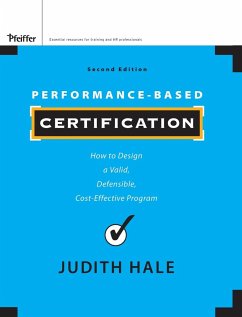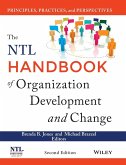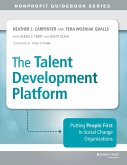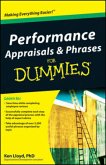- Gebundenes Buch
- Merkliste
- Auf die Merkliste
- Bewerten Bewerten
- Teilen
- Produkt teilen
- Produkterinnerung
- Produkterinnerung
Are your employees qualified? Looking for qualified people to do competent work? How do you ensure that the people you hire can do the job right? An ever-increasing number of organizations are asking the same questions. Certification planning is the answer and Performance-Based Certification is the key. This is the only book on the market that addresses the growing need to monitor the qualifications of employees. You'll be able to quickly customize the certification tests and other job aids provided on the accompanying disk. Create a certification program within your organization to: Instill…mehr
Andere Kunden interessierten sich auch für
![Respect Respect]() Jack WileyRespect53,99 €
Jack WileyRespect53,99 €![Virtual Team Success Virtual Team Success]() Richard LepsingerVirtual Team Success74,99 €
Richard LepsingerVirtual Team Success74,99 €![Closing the Execution Gap Closing the Execution Gap]() Richard LepsingerClosing the Execution Gap60,99 €
Richard LepsingerClosing the Execution Gap60,99 €![The Ntl Handbook of Organization Development and Change The Ntl Handbook of Organization Development and Change]() Brenda B. JonesThe Ntl Handbook of Organization Development and Change148,99 €
Brenda B. JonesThe Ntl Handbook of Organization Development and Change148,99 €![The Talent Development Platform The Talent Development Platform]() Heather CarpenterThe Talent Development Platform53,99 €
Heather CarpenterThe Talent Development Platform53,99 €![Performance Appraisals & Phrases for Dummies Performance Appraisals & Phrases for Dummies]() Ken LloydPerformance Appraisals & Phrases for Dummies18,99 €
Ken LloydPerformance Appraisals & Phrases for Dummies18,99 €![Handbook of Improving Performance in the Workplace, Measurement and Evaluation Handbook of Improving Performance in the Workplace, Measurement and Evaluation]() Handbook of Improving Performance in the Workplace, Measurement and Evaluation196,99 €
Handbook of Improving Performance in the Workplace, Measurement and Evaluation196,99 €-
-
-
Are your employees qualified?
Looking for qualified people to do competent work? How do you ensure that the people you hire can do the job right? An ever-increasing number of organizations are asking the same questions.
Certification planning is the answer and Performance-Based Certification is the key. This is the only book on the market that addresses the growing need to monitor the qualifications of employees. You'll be able to quickly customize the certification tests and other job aids provided on the accompanying disk.
Create a certification program within your organization to:
Instill confidence that employees, members, or suppliers are qualified to meet the needs of your customers
Ensure that your workforce is trained and competent to their job
Make your hiring process more cost effective and legally defendable
Recognize competence and consistency of your employees
Once you've identified the need for a certification program, what's the next step? All of the answers are here!
Hinweis: Dieser Artikel kann nur an eine deutsche Lieferadresse ausgeliefert werden.
Looking for qualified people to do competent work? How do you ensure that the people you hire can do the job right? An ever-increasing number of organizations are asking the same questions.
Certification planning is the answer and Performance-Based Certification is the key. This is the only book on the market that addresses the growing need to monitor the qualifications of employees. You'll be able to quickly customize the certification tests and other job aids provided on the accompanying disk.
Create a certification program within your organization to:
Instill confidence that employees, members, or suppliers are qualified to meet the needs of your customers
Ensure that your workforce is trained and competent to their job
Make your hiring process more cost effective and legally defendable
Recognize competence and consistency of your employees
Once you've identified the need for a certification program, what's the next step? All of the answers are here!
Hinweis: Dieser Artikel kann nur an eine deutsche Lieferadresse ausgeliefert werden.
Produktdetails
- Produktdetails
- Verlag: Wiley & Sons
- 2. Aufl.
- Seitenzahl: 288
- Erscheinungstermin: 27. Dezember 2011
- Englisch
- Abmessung: 260mm x 208mm x 20mm
- Gewicht: 703g
- ISBN-13: 9781118027240
- ISBN-10: 1118027248
- Artikelnr.: 33767312
- Herstellerkennzeichnung
- Libri GmbH
- Europaallee 1
- 36244 Bad Hersfeld
- gpsr@libri.de
- Verlag: Wiley & Sons
- 2. Aufl.
- Seitenzahl: 288
- Erscheinungstermin: 27. Dezember 2011
- Englisch
- Abmessung: 260mm x 208mm x 20mm
- Gewicht: 703g
- ISBN-13: 9781118027240
- ISBN-10: 1118027248
- Artikelnr.: 33767312
- Herstellerkennzeichnung
- Libri GmbH
- Europaallee 1
- 36244 Bad Hersfeld
- gpsr@libri.de
JUDITH HALE is president of the consulting firm Hale Associates. Their services include consultation on assessment, certification, evaluation, and integration of performance improvement systems with performance management. She is also the author of the Performance Consultant's Fieldbook, Performance-Based Evaluation. Performance-Based Management, and Outsourcing Training and Management, all from Pfeiffer.
List of Tables, Figures, and Exhibits xi
Contents of the Website xiii
Introduction 1
Chapter 1 The Driver 11
Why Organizations Certify 11
Protecting the Public 12
Reinforcing Professional Stature and Promoting Universal Standards 13
Preparing People for Jobs Requiring Competence in Multiple Disciplines 14
Protecting Jobs and Enhancing Professional Stature 15
Improving Business Processes 16
Establishing Professional Credibility and Influencing Academic Curricula 18
Establishing Uniform Performance Standards 18
Protecting the Brand Name 19
Raising the Level of Core Competencies 20
Success Measures 21
Who to Involve 21
The Players 21
Target Audience 22
Stakeholders 22
Benefits of Certification 25
Missteps and Oversights 26
Tips 27
Summary 30
Where to Learn More 31
Notes 32
Chapter 2 The Business Case 33
What Goes into a Business Case 34
Hypotheses, Premises, and Best Guesses 36
Metrics or Key Success Indicators 37
Economic Metrics 39
Noneconomic Metrics 42
The Requirements 43
Missteps and Oversights 43
Tips 44
Summary 48
Where to Learn More 50
Note 51
Chapter 3 The Requirements 53
Distinctions Among Eligibility, Qualification, and Certification 53
Roles Certification Plays 54
Gatekeeping or Screening 54
Recognizing Demonstrated Performance 57
Recognizing Different Levels of Accomplishment or Different Capabilities 57
Typical Requirements for Certification 58
Acceptance of a Code of Conduct 61
Eligibility 61
Education, Training, and Development 65
Endorsements 67
Experience 67
External Credentials 69
Tests 69
Work Samples 72
Work or Personnel Records 72
Maintenance and Recertification 73
Missteps and Oversights 74
Tips 74
Summary 76
Where to Learn More 77
Notes 78
Chapter 4 The Standards 79
Competencies, Standards, and Criteria 81
Defining the Scope of the Effort 85
The Job or Task Analysis 89
Traditional Job/Task Analysis Methodologies 89
Controlling Bias 91
Sampling Error 92
Design Error 95
Administrative Error 109
Design of the Credential 111
Certification vs. Certificate 111
The Elements 114
Missteps and Oversights 115
Tips 116
Standards 118
The Design 119
Summary 119
Procedures 121
Focus Groups 121
The NGT 122
Outcome-Based Competency Session 123
Delphi Study 124
Where to Learn More 125
Note 126
Chapter 5 Assessment 127
Definitions 127
Rigor and Validity 130
Sampling Error 131
Under-Representation 131
Extraneous Abilities 132
Test Specifications 133
Design Errors 134
Administrative Error 136
Types of Test Items 137
Response-Supplied Items 137
Response-Not-Supplied Items 138
Computer-Based Testing 141
Determining the Passing Score 142
Informed Judgment Method 143
Contrasting Group Method 143
Conjectural (Angoff-Nedelsky) Method 145
Issues in Assessment and Testing 146
Opportunity to Learn 146
Adequate Time and Resources 147
Face Validity 147
Documentation 148
Missteps and Oversights 148
Tips 149
Summary 155
Where to Learn More 161
Chapter 6 Governance and Administration 163
Responsibilities of the Governance Board 163
Candidate Rights 165
Disclosure 165
Appeals and Exemptions 167
Preparation and Remediation 169
Ethics 170
Fees and Compensation 170
Test Administration 174
Responsibilities of the Program Administrator 175
Establishing Administrative Support Systems 176
Analyzing Test Items 177
Missteps and Oversights 178
Tips 179
Summary 187
Where to Learn More 190
Notes 191
Chapter 7 Recertification and Maintenance 193
Stability of Enabling Knowledge 194
Distinguishing Between Knowledge Atrophy and Knowledge Evolution 195
Defining the Purpose of Recertification or Maintenance 198
Redoing the Job/Task Analysis 199
Timing the Requirement 200
Missteps and Oversights 201
Tips 201
Summary 203
Where to Learn More 205
Chapter 8 Implementation 207
The Marketing Strategy 208
Defining the Market 209
Branding the Credential 210
Launching the Credential 211
Rolling Out the Credential and Penetrating a Market 212
Developing and Executing a Communication Plan 213
Developing Effective Program Materials 214
Celebrating Success 215
Missteps and Oversights 216
Tips 217
Summary 220
Where to Learn More 220
Chapter 9 Going Global 221
Distinctions Among National, International, Global, and Multi-National
Programs 221
Why Go Global or International? 224
Determining Reciprocity, Equivalency, and Exemptions 225
Safeguarding Against Fraud or Misrepresentation 226
Cultural Issues 227
Language and Translation 227
Missteps and Oversights 229
Tips 230
Summary 230
Where to Learn More 233
Note 233
Chapter 10 Evaluation 235
Developing an Evaluation Strategy 235
Defining Evaluation Processes 236
Determining What to Measure 237
Determining Where to Start 238
Being Clear About Your Purpose 242
Developing an Agenda 244
Presenting Your Data 244
Missteps and Oversights 246
Tips 247
Summary 248
Where to Learn More 251
Index 253
About the Author 269
Contents of the Website xiii
Introduction 1
Chapter 1 The Driver 11
Why Organizations Certify 11
Protecting the Public 12
Reinforcing Professional Stature and Promoting Universal Standards 13
Preparing People for Jobs Requiring Competence in Multiple Disciplines 14
Protecting Jobs and Enhancing Professional Stature 15
Improving Business Processes 16
Establishing Professional Credibility and Influencing Academic Curricula 18
Establishing Uniform Performance Standards 18
Protecting the Brand Name 19
Raising the Level of Core Competencies 20
Success Measures 21
Who to Involve 21
The Players 21
Target Audience 22
Stakeholders 22
Benefits of Certification 25
Missteps and Oversights 26
Tips 27
Summary 30
Where to Learn More 31
Notes 32
Chapter 2 The Business Case 33
What Goes into a Business Case 34
Hypotheses, Premises, and Best Guesses 36
Metrics or Key Success Indicators 37
Economic Metrics 39
Noneconomic Metrics 42
The Requirements 43
Missteps and Oversights 43
Tips 44
Summary 48
Where to Learn More 50
Note 51
Chapter 3 The Requirements 53
Distinctions Among Eligibility, Qualification, and Certification 53
Roles Certification Plays 54
Gatekeeping or Screening 54
Recognizing Demonstrated Performance 57
Recognizing Different Levels of Accomplishment or Different Capabilities 57
Typical Requirements for Certification 58
Acceptance of a Code of Conduct 61
Eligibility 61
Education, Training, and Development 65
Endorsements 67
Experience 67
External Credentials 69
Tests 69
Work Samples 72
Work or Personnel Records 72
Maintenance and Recertification 73
Missteps and Oversights 74
Tips 74
Summary 76
Where to Learn More 77
Notes 78
Chapter 4 The Standards 79
Competencies, Standards, and Criteria 81
Defining the Scope of the Effort 85
The Job or Task Analysis 89
Traditional Job/Task Analysis Methodologies 89
Controlling Bias 91
Sampling Error 92
Design Error 95
Administrative Error 109
Design of the Credential 111
Certification vs. Certificate 111
The Elements 114
Missteps and Oversights 115
Tips 116
Standards 118
The Design 119
Summary 119
Procedures 121
Focus Groups 121
The NGT 122
Outcome-Based Competency Session 123
Delphi Study 124
Where to Learn More 125
Note 126
Chapter 5 Assessment 127
Definitions 127
Rigor and Validity 130
Sampling Error 131
Under-Representation 131
Extraneous Abilities 132
Test Specifications 133
Design Errors 134
Administrative Error 136
Types of Test Items 137
Response-Supplied Items 137
Response-Not-Supplied Items 138
Computer-Based Testing 141
Determining the Passing Score 142
Informed Judgment Method 143
Contrasting Group Method 143
Conjectural (Angoff-Nedelsky) Method 145
Issues in Assessment and Testing 146
Opportunity to Learn 146
Adequate Time and Resources 147
Face Validity 147
Documentation 148
Missteps and Oversights 148
Tips 149
Summary 155
Where to Learn More 161
Chapter 6 Governance and Administration 163
Responsibilities of the Governance Board 163
Candidate Rights 165
Disclosure 165
Appeals and Exemptions 167
Preparation and Remediation 169
Ethics 170
Fees and Compensation 170
Test Administration 174
Responsibilities of the Program Administrator 175
Establishing Administrative Support Systems 176
Analyzing Test Items 177
Missteps and Oversights 178
Tips 179
Summary 187
Where to Learn More 190
Notes 191
Chapter 7 Recertification and Maintenance 193
Stability of Enabling Knowledge 194
Distinguishing Between Knowledge Atrophy and Knowledge Evolution 195
Defining the Purpose of Recertification or Maintenance 198
Redoing the Job/Task Analysis 199
Timing the Requirement 200
Missteps and Oversights 201
Tips 201
Summary 203
Where to Learn More 205
Chapter 8 Implementation 207
The Marketing Strategy 208
Defining the Market 209
Branding the Credential 210
Launching the Credential 211
Rolling Out the Credential and Penetrating a Market 212
Developing and Executing a Communication Plan 213
Developing Effective Program Materials 214
Celebrating Success 215
Missteps and Oversights 216
Tips 217
Summary 220
Where to Learn More 220
Chapter 9 Going Global 221
Distinctions Among National, International, Global, and Multi-National
Programs 221
Why Go Global or International? 224
Determining Reciprocity, Equivalency, and Exemptions 225
Safeguarding Against Fraud or Misrepresentation 226
Cultural Issues 227
Language and Translation 227
Missteps and Oversights 229
Tips 230
Summary 230
Where to Learn More 233
Note 233
Chapter 10 Evaluation 235
Developing an Evaluation Strategy 235
Defining Evaluation Processes 236
Determining What to Measure 237
Determining Where to Start 238
Being Clear About Your Purpose 242
Developing an Agenda 244
Presenting Your Data 244
Missteps and Oversights 246
Tips 247
Summary 248
Where to Learn More 251
Index 253
About the Author 269
List of Tables, Figures, and Exhibits xi
Contents of the Website xiii
Introduction 1
Chapter 1 The Driver 11
Why Organizations Certify 11
Protecting the Public 12
Reinforcing Professional Stature and Promoting Universal Standards 13
Preparing People for Jobs Requiring Competence in Multiple Disciplines 14
Protecting Jobs and Enhancing Professional Stature 15
Improving Business Processes 16
Establishing Professional Credibility and Influencing Academic Curricula 18
Establishing Uniform Performance Standards 18
Protecting the Brand Name 19
Raising the Level of Core Competencies 20
Success Measures 21
Who to Involve 21
The Players 21
Target Audience 22
Stakeholders 22
Benefits of Certification 25
Missteps and Oversights 26
Tips 27
Summary 30
Where to Learn More 31
Notes 32
Chapter 2 The Business Case 33
What Goes into a Business Case 34
Hypotheses, Premises, and Best Guesses 36
Metrics or Key Success Indicators 37
Economic Metrics 39
Noneconomic Metrics 42
The Requirements 43
Missteps and Oversights 43
Tips 44
Summary 48
Where to Learn More 50
Note 51
Chapter 3 The Requirements 53
Distinctions Among Eligibility, Qualification, and Certification 53
Roles Certification Plays 54
Gatekeeping or Screening 54
Recognizing Demonstrated Performance 57
Recognizing Different Levels of Accomplishment or Different Capabilities 57
Typical Requirements for Certification 58
Acceptance of a Code of Conduct 61
Eligibility 61
Education, Training, and Development 65
Endorsements 67
Experience 67
External Credentials 69
Tests 69
Work Samples 72
Work or Personnel Records 72
Maintenance and Recertification 73
Missteps and Oversights 74
Tips 74
Summary 76
Where to Learn More 77
Notes 78
Chapter 4 The Standards 79
Competencies, Standards, and Criteria 81
Defining the Scope of the Effort 85
The Job or Task Analysis 89
Traditional Job/Task Analysis Methodologies 89
Controlling Bias 91
Sampling Error 92
Design Error 95
Administrative Error 109
Design of the Credential 111
Certification vs. Certificate 111
The Elements 114
Missteps and Oversights 115
Tips 116
Standards 118
The Design 119
Summary 119
Procedures 121
Focus Groups 121
The NGT 122
Outcome-Based Competency Session 123
Delphi Study 124
Where to Learn More 125
Note 126
Chapter 5 Assessment 127
Definitions 127
Rigor and Validity 130
Sampling Error 131
Under-Representation 131
Extraneous Abilities 132
Test Specifications 133
Design Errors 134
Administrative Error 136
Types of Test Items 137
Response-Supplied Items 137
Response-Not-Supplied Items 138
Computer-Based Testing 141
Determining the Passing Score 142
Informed Judgment Method 143
Contrasting Group Method 143
Conjectural (Angoff-Nedelsky) Method 145
Issues in Assessment and Testing 146
Opportunity to Learn 146
Adequate Time and Resources 147
Face Validity 147
Documentation 148
Missteps and Oversights 148
Tips 149
Summary 155
Where to Learn More 161
Chapter 6 Governance and Administration 163
Responsibilities of the Governance Board 163
Candidate Rights 165
Disclosure 165
Appeals and Exemptions 167
Preparation and Remediation 169
Ethics 170
Fees and Compensation 170
Test Administration 174
Responsibilities of the Program Administrator 175
Establishing Administrative Support Systems 176
Analyzing Test Items 177
Missteps and Oversights 178
Tips 179
Summary 187
Where to Learn More 190
Notes 191
Chapter 7 Recertification and Maintenance 193
Stability of Enabling Knowledge 194
Distinguishing Between Knowledge Atrophy and Knowledge Evolution 195
Defining the Purpose of Recertification or Maintenance 198
Redoing the Job/Task Analysis 199
Timing the Requirement 200
Missteps and Oversights 201
Tips 201
Summary 203
Where to Learn More 205
Chapter 8 Implementation 207
The Marketing Strategy 208
Defining the Market 209
Branding the Credential 210
Launching the Credential 211
Rolling Out the Credential and Penetrating a Market 212
Developing and Executing a Communication Plan 213
Developing Effective Program Materials 214
Celebrating Success 215
Missteps and Oversights 216
Tips 217
Summary 220
Where to Learn More 220
Chapter 9 Going Global 221
Distinctions Among National, International, Global, and Multi-National
Programs 221
Why Go Global or International? 224
Determining Reciprocity, Equivalency, and Exemptions 225
Safeguarding Against Fraud or Misrepresentation 226
Cultural Issues 227
Language and Translation 227
Missteps and Oversights 229
Tips 230
Summary 230
Where to Learn More 233
Note 233
Chapter 10 Evaluation 235
Developing an Evaluation Strategy 235
Defining Evaluation Processes 236
Determining What to Measure 237
Determining Where to Start 238
Being Clear About Your Purpose 242
Developing an Agenda 244
Presenting Your Data 244
Missteps and Oversights 246
Tips 247
Summary 248
Where to Learn More 251
Index 253
About the Author 269
Contents of the Website xiii
Introduction 1
Chapter 1 The Driver 11
Why Organizations Certify 11
Protecting the Public 12
Reinforcing Professional Stature and Promoting Universal Standards 13
Preparing People for Jobs Requiring Competence in Multiple Disciplines 14
Protecting Jobs and Enhancing Professional Stature 15
Improving Business Processes 16
Establishing Professional Credibility and Influencing Academic Curricula 18
Establishing Uniform Performance Standards 18
Protecting the Brand Name 19
Raising the Level of Core Competencies 20
Success Measures 21
Who to Involve 21
The Players 21
Target Audience 22
Stakeholders 22
Benefits of Certification 25
Missteps and Oversights 26
Tips 27
Summary 30
Where to Learn More 31
Notes 32
Chapter 2 The Business Case 33
What Goes into a Business Case 34
Hypotheses, Premises, and Best Guesses 36
Metrics or Key Success Indicators 37
Economic Metrics 39
Noneconomic Metrics 42
The Requirements 43
Missteps and Oversights 43
Tips 44
Summary 48
Where to Learn More 50
Note 51
Chapter 3 The Requirements 53
Distinctions Among Eligibility, Qualification, and Certification 53
Roles Certification Plays 54
Gatekeeping or Screening 54
Recognizing Demonstrated Performance 57
Recognizing Different Levels of Accomplishment or Different Capabilities 57
Typical Requirements for Certification 58
Acceptance of a Code of Conduct 61
Eligibility 61
Education, Training, and Development 65
Endorsements 67
Experience 67
External Credentials 69
Tests 69
Work Samples 72
Work or Personnel Records 72
Maintenance and Recertification 73
Missteps and Oversights 74
Tips 74
Summary 76
Where to Learn More 77
Notes 78
Chapter 4 The Standards 79
Competencies, Standards, and Criteria 81
Defining the Scope of the Effort 85
The Job or Task Analysis 89
Traditional Job/Task Analysis Methodologies 89
Controlling Bias 91
Sampling Error 92
Design Error 95
Administrative Error 109
Design of the Credential 111
Certification vs. Certificate 111
The Elements 114
Missteps and Oversights 115
Tips 116
Standards 118
The Design 119
Summary 119
Procedures 121
Focus Groups 121
The NGT 122
Outcome-Based Competency Session 123
Delphi Study 124
Where to Learn More 125
Note 126
Chapter 5 Assessment 127
Definitions 127
Rigor and Validity 130
Sampling Error 131
Under-Representation 131
Extraneous Abilities 132
Test Specifications 133
Design Errors 134
Administrative Error 136
Types of Test Items 137
Response-Supplied Items 137
Response-Not-Supplied Items 138
Computer-Based Testing 141
Determining the Passing Score 142
Informed Judgment Method 143
Contrasting Group Method 143
Conjectural (Angoff-Nedelsky) Method 145
Issues in Assessment and Testing 146
Opportunity to Learn 146
Adequate Time and Resources 147
Face Validity 147
Documentation 148
Missteps and Oversights 148
Tips 149
Summary 155
Where to Learn More 161
Chapter 6 Governance and Administration 163
Responsibilities of the Governance Board 163
Candidate Rights 165
Disclosure 165
Appeals and Exemptions 167
Preparation and Remediation 169
Ethics 170
Fees and Compensation 170
Test Administration 174
Responsibilities of the Program Administrator 175
Establishing Administrative Support Systems 176
Analyzing Test Items 177
Missteps and Oversights 178
Tips 179
Summary 187
Where to Learn More 190
Notes 191
Chapter 7 Recertification and Maintenance 193
Stability of Enabling Knowledge 194
Distinguishing Between Knowledge Atrophy and Knowledge Evolution 195
Defining the Purpose of Recertification or Maintenance 198
Redoing the Job/Task Analysis 199
Timing the Requirement 200
Missteps and Oversights 201
Tips 201
Summary 203
Where to Learn More 205
Chapter 8 Implementation 207
The Marketing Strategy 208
Defining the Market 209
Branding the Credential 210
Launching the Credential 211
Rolling Out the Credential and Penetrating a Market 212
Developing and Executing a Communication Plan 213
Developing Effective Program Materials 214
Celebrating Success 215
Missteps and Oversights 216
Tips 217
Summary 220
Where to Learn More 220
Chapter 9 Going Global 221
Distinctions Among National, International, Global, and Multi-National
Programs 221
Why Go Global or International? 224
Determining Reciprocity, Equivalency, and Exemptions 225
Safeguarding Against Fraud or Misrepresentation 226
Cultural Issues 227
Language and Translation 227
Missteps and Oversights 229
Tips 230
Summary 230
Where to Learn More 233
Note 233
Chapter 10 Evaluation 235
Developing an Evaluation Strategy 235
Defining Evaluation Processes 236
Determining What to Measure 237
Determining Where to Start 238
Being Clear About Your Purpose 242
Developing an Agenda 244
Presenting Your Data 244
Missteps and Oversights 246
Tips 247
Summary 248
Where to Learn More 251
Index 253
About the Author 269








